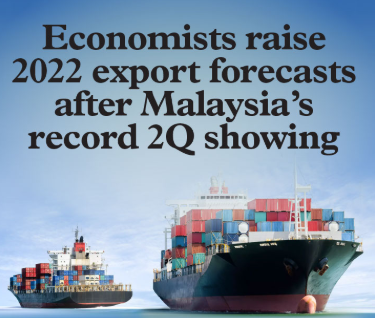Economists raise 2022 export forecasts after Malaysia's record 2Q showing

Malaysia's exports rose 38.8% year-on-year in June to RM146.16 billion, driven by strong demand for electrical and electronic (E&E) products, petroleum products, liquefied natural gas as well as palm oil and palm-oil based agriculture products, prompting economists to raise their full year 2022 export forecasts even as they caution of the possibility of slower growth momentum in the second half of 2022.
由于对电气和电子(E&E)产品、石油产品、液化天然气以及棕榈油和以棕榈油为基础的农产品,促使经济学家上调 2022 年全年出口预测,尽管他们警告称 2022 年下半年增长势头可能放缓。
The expansion is the 11th consecutive month of double-digit growth for the country's exports — above the 20.1% rise forecast in a Reuters poll, and higher than Bloomberg's 21.2% consensus expectation — and up from the 30.5% growth posted in May.
这一扩张是该国出口连续第 11 个月实现两位数增长——高于路透社调查中预测的 20.1% 的增长,也高于彭博社 21.2% 的普遍预期——并且高于 5 月份公布的 30.5% 的增长。
The stronger export showing came as exports to most major trading partners, notably Singapore, US, European Union (EU) and Japan recorded double-digit growths. Singapore registered the highest export value increase of RM9 billion, followed by RM3.9 billion to the US, RM3.5 billion to the EU, and RM3.1 billion to Japan.
由于对大多数主要贸易伙伴,尤其是新加坡、美国、欧盟(EU)和日本的出口录得两位数增长,出口表现强劲。新加坡的出口值增幅最高,达 90 亿令吉,其次是对美国的 39 亿令吉、对欧盟的 35 亿令吉和对日本的 31 亿令吉。
Total trade for the month rose 43.4% y-o-y to RM270.39 billion — the 17th consecutive month of double digit growth — while imports jumped 49.3% y-o-y to RM124.23 billion. The increase in imports were driven by petroleum products (up RM11.7 billion); E&E products (up RM9.3 billion); transport equipment (up RM2.6 billion) and crude petroleum (up RM2.6 billion). As imports grew faster than exports, trade surplus declined a marginal 0.8% y-o-y to RM21.93 billion.
本月总贸易额按年增长 43.4% 至 2703.9 亿令吉——连续第 17 个月实现两位数增长——而进口按年增长 49.3% 至 1242.3 亿令吉。石油产品推动进口增加(增加 117 亿令吉);电子电气产品(增加 93 亿令吉);运输设备(上涨 26 亿令吉)和原油(上涨 26 亿令吉)。由于进口增长快于出口,贸易顺差按年微跌 0.8% 至 219.3 亿令吉。
On a month-on-month basis, trade expanded by 18.4%, exports grew 21.3% and imports rose 15.2%, while trade surplus expanded 72.7%.
环比,贸易增长18.4%,出口增长21.3%,进口增长15.2%,贸易顺差扩大72.7%。
With the June figures, total trade for the second quarter of 2022 grew 32.7% to RM730.36 billion compared with 2Q2021. Exports climbed 30% y-o-y to RM394.24 billion and imports increased 36.1% y-o-y to RM336.13 billion. "This was the highest quarterly value for total trade, exports and imports thus far. A trade surplus of RM58.1 billion was recorded for the period, shrinking by 10.6%," according to a statement from the Department of Statistics Malaysia.
根据 6 月份的数据,与 2021 年第二季度相比,2022 年第二季度的总贸易额增长 32.7% 至 7,303.6 亿令吉。出口同比增长 30% 至 3942.4 亿令吉,进口同比增长 36.1% 至 3361.3 亿令吉。“这是迄今为止贸易、进出口总额的最高季度值。根据马来西亚统计局的一份声明,该期间的贸易顺差为 581 亿令吉,减少了 10.6%。”
For the first half of 2022, total trade grew 28.2% to RM1.355 trillion from 1H2021, exports rose 26.1% to RM739.13 billion, while imports grew 30.9% to RM616.00 billion; consequently, trade surplus climbed 6.7% to RM123.13 billion.
2022 年上半年,贸易总额较 2021 年上半年增长 28.2% 至 1.355 万亿令吉,出口增长 26.1% 至 7,391.3 亿令吉,而进口增长 30.9% 至 6,160 亿令吉;因此,贸易顺差攀升 6.7% 至 1231.3 亿令吉。
Slower global growth could hurt Malaysia's trade outlook
全球增长放缓可能损害马来西亚的贸易前景
Despite the strong 1H2022 growth, economists are wary that slower global growth could hurt Malaysia's trade outlook for the second half of the year.
尽管 1H2022 增长强劲,但经济学家担心全球增长放缓可能会损害马来西亚下半年的贸易前景。
Risks could come from weaker global demand amid rising global inflation, a possible sharp slowdown in the US due to aggressive monetary tightening and a shortage of raw materials or supply chain disruption, besides weak recovery in China following the Covid-19 lockdowns there earlier this year.
风险可能来自全球通胀上升导致全球需求疲软,美国可能因激进的货币紧缩政策和原材料短缺或供应链中断而急剧放缓,此外中国在今年早些时候 Covid-19 封锁后复苏乏力.
The drag could come from the E&E and commodity sectors, they said.
他们表示,拖累可能来自电子电气和大宗商品行业。
In particular, UOB Global Economics & Markets Research economists Julia Goh and Loke Siew Ting pointed out that the near-term outlook for Malaysian palm oil exports is clouded, with the recent sharp decline in crude palm oil prices (CPO).
尤其是大华银行全球经济与市场研究经济学家Julia Goh和Loke Siew Ting指出,由于近期毛棕榈油价格(CPO)急剧下跌,马来西亚棕榈油出口的近期前景阴云密布。
“The rapid fall in CPO prices has also prompted contract renegotiations between CPO traders and buyers who are taking the deliveries now. However, surging supplies in global top exporter Indonesia and its removal of export levy for all palm oil products until Aug 31, 2022 could further depress CPO prices and affect Malaysia’s palm oil shipments over the next few months,”
they wrote in a note.
“原棕油价格的快速下跌也促使原棕油贸易商和现在正在收货的买家重新谈判合同。然而,全球最大出口国印度尼西亚的供应激增,以及在 2022 年 8 月 31 日之前取消所有棕榈油产品的出口税,可能会进一步压低原棕油价格,并影响马来西亚未来几个月的棕榈油出货量,”
Locally, foreign labour shortage will further constrain manufacturers’ production capacity even as demand remains decent, the duo added.
两人补充说,在本地,即使需求仍然不错,外国劳动力短缺将进一步限制制造商的生产能力。
RHB Research economist Chin Yee Sian, meanwhile, highlighted that June data had already shown some signs of slowing momentum in exports to the US and China. "The momentum of outbound shipments to China [has been] trending downwards since the beginning of the year amid slower economic activities in China due to continued implementation of strict containment measures.
与此同时,兴业研究经济学家Chin Yee Sian强调,6月份的数据已经显示出对美国和中国出口势头放缓的一些迹象。“自今年年初以来,由于继续实施严格的遏制措施,中国经济活动放缓,对中国的出境货运势头[一直]呈下降趋势。
"To recap, China GDP growth has contracted by 2.6% in 2Q22 (0.4% y-o-y) compared with the last quarter. The emergence of a more infectious strain of Covid-19’s Omicron variant as reported in some major China’s cities is likely to lead to higher uncertainties," Chin wrote in a separate note.
“回顾一下,与上一季度相比,2Q22 的中国 GDP 增长收缩了 2.6%(同比增长 0.4%)。据报道,中国一些主要城市出现了更具传染性的 Covid-19 的 Omicron 变体,这可能会导致更高的不确定性,”Chin 在另一份报告中写道。
Nevertheless, UOB and MIDF raised their 2022 export growth forecast after factoring in the robust 26.1% growth in 1H22. UOB raised its export forecast to 18% from 8% previously, while MIDF upgraded it to 20.9% from 16.9%. MIDF also raised its imports forecast to 25.6% from 19.2%.
尽管如此,在考虑到 1H22 强劲的 26.1% 增长后,大华银行和 MIDF 上调了 2022 年的出口增长预测。大华银行将其出口预测从之前的 8% 上调至 18%,而 MIDF 将其从 16.9% 上调至 20.9%。MIDF 还将其进口预测从 19.2% 上调至 25.6%。
“We expect growing external demand for E&E and commodities, particularly palm oil and petroleum products, to drive overall exports growth this year, and the firm imports growth will continue on the back of continued improvement in domestic economic activities,” the MIDF wrote in another note.
MIDF 在另一篇文章中写道:“我们预计,对电子电气和大宗商品,尤其是棕榈油和石油产品的外部需求不断增长,将推动今年的整体出口增长,而在国内经济活动持续改善的情况下,进口增长将继续保持强劲”。
RHB is expecting a full-year export growth of 21.9%. "We opine that uncertainties in the global landscape might taper the upward momentum of the trade performance. We expect Malaysia’s exports to register a full-year growth of 21.9% with slower export growth expected in 2H2022, affected by a bleaker global economic outlook," Chin added.
兴业银行预计全年出口增长 21.9%。Chin补充道,“我们认为,全球格局的不确定性可能会削弱贸易表现的上升势头。我们预计马来西亚的出口将录得 21.9% 的全年增长,预计 2022 年第二季度的出口增长将放缓,受全球经济前景黯淡的影响。”
